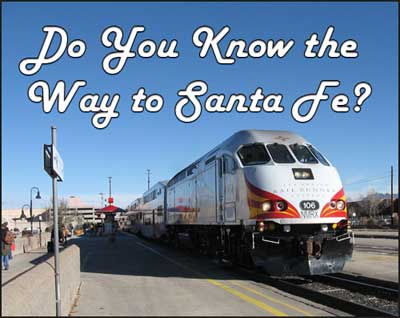 Santa Fe Revisited
Santa Fe Revisited The museums in Santa Fe don’t open until ten a.m.
I should have known this because I used to live there: I was a student at St. John’s College for four years and then worked as a typesetter for three years at The Santa Fe Reporter.
But 26 years had gone by since I left Santa Fe and I was now just another disoriented tourist, freezing my ass off in the rail yar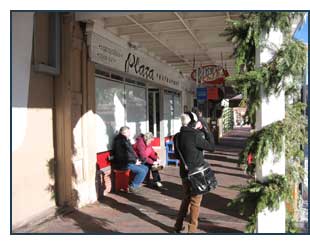 ds at eight in the morning, bored out of my mind.
ds at eight in the morning, bored out of my mind.
So I headed downtown, ate breakfast at the Plaza Café and thanked the gods that it had not been turned into an art gallery. I wolfed down a bowl of menudo, drank a cup of coffee and walked across the Plaza into La Fonda Hotel.
I entered the lobby, sat down in a leather chair and studied the hotel’s wooden vigas and soft adobe 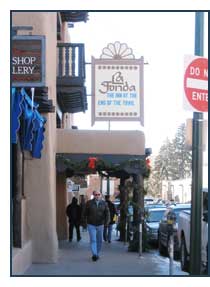 walls. Then a ghost, dressed in a dusty cowboy outfit, ambled up to me and said, “My name’s Roger W. Birdseye. I used to handle publicity for the Fred Harvey Company.”
walls. Then a ghost, dressed in a dusty cowboy outfit, ambled up to me and said, “My name’s Roger W. Birdseye. I used to handle publicity for the Fred Harvey Company.”
I began to wonder what was in that menudo.
“Harvey leased this Hotel from the Atchison, Topeka, Santa Fe Railroad,” Birdseye said. “Did you get off the train from Lamy?”
“No. I just got in from Albuquerque but we didn’t go through Lamy. The train climbed La Bajada Hill.”
“There’s no way in hell a steam locomotive can climb La Bajada Hill,” Birdseye said, spitting tobacco juice on the floor, just missing my shoe.
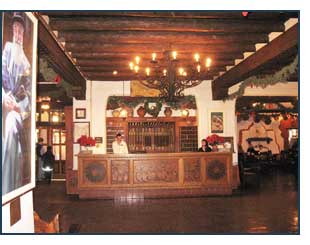 “It wasn’t a steam locomotive. It was diesel-electric.”
“It wasn’t a steam locomotive. It was diesel-electric.”
“Don’t gimmee none of your backtalk, boy. Who the hell are you?”
“My name’s Chuck Reuben. I used to be a newspaperman.”
“I reckoned you were a kindred spirit,” Birdseye said eyeing my laptop, “Nobody but a writer would walk into this hotel and peck away at a fancy typesetting machine when he could be watching the fine ladies.”
He nodded at a woman wearing blue jean cut-offs and a tank top and winked at me.
“Oooh weee! If only ol’ Fred Harvey had dressed ‘em up like that!”
“What did you do for the Harvey Company?” I asked.
He grabbed a seat next to me. His breath stank of whisky.
“They had me promoting a three-day motor car excursion called the Indian Detour. For $40 a weary 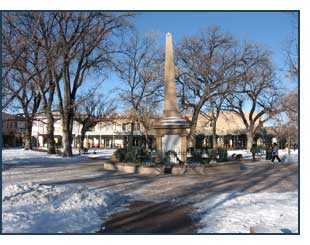 traveler could climb into a Packard Harveycar and enjoy three days and 300 miles of sunshine, relaxation and mountain air.”
traveler could climb into a Packard Harveycar and enjoy three days and 300 miles of sunshine, relaxation and mountain air.”
“That sounds like a heluva deal,” I said sarcastically, figuring that same $40 would be worth at least $800 in today’s money.
“The Indian Detour ran between the Castaneda Harvey House in Las Vegas, New Mexico, the Alvarado Harvey House in Albuquerque and this hotel. What’s become of those other places, boy?”
“Well, they tore down the Alvarado Hotel and built a city bus station in its place. And last I heard, the Castaneda was abandoned and going to seed.”
“Figures ,” said Birdseye in disgust. “Hey boy, did you really climb La Bajada Hill on a train?”
“Yeah,” I said, “and I made the trip in an hour and a half! I was just going to write about it.”
“You must have been traveling like greased lightning, boy. You don’t mind if I read over your shoulder, do you? I could help you with your spelling.”
“It would be an honor, sir.”
And so I picked up my laptop, collected my notes and began to type. The old-timer read over my shoulder, occasionally stealing a glance at the young ladies who made their way through the lobby.

It took me 15 minutes to ride my bike from my house in Old Town to the Albuquerque Transit Center, or the ATC as it is known. I took my bike to the station because the bus doesn’t run at the crack of dawn.
The ATC is located where the Alvarado Hotel used to be. That is, before it was demolished on Friday the 13th in February of 1970. The railroad knocked down the Alvarado because the city wouldn’t pony up the $1.5 million dollars that it would have taken to save it.
Behind the ATC is the platform for the New Mexico Rail Runner Express, which it shares with Amtrak’s Southwest Chief. The Rail Runner serves the metropolitan areas of Albuquerque and it would now serve Santa Fe. This was its f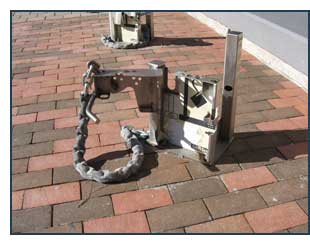 irst weekend of service and since I figured this was one of New Mexico’s finest hours, I wanted to be part of it.
irst weekend of service and since I figured this was one of New Mexico’s finest hours, I wanted to be part of it.
In preparation for my train ride to Santa Fe I spent five frantic minutes trying to secure my bike to a monstrous, polished aluminum lock located on the north side of the transit center. The instructions on the lock were faded by the sun and seemed to have been written in Chinese hieroglyphics. A bystander, wearing a green Leprechaun hat, offered to help.
A security guard approached and watched in amusement. Then a crowd gathered around, pointing and laughing at me. I was getting mightily pissed off.
The guard bragged, “I’ve watched a bike parked in front of the station get stripped in under 30 minutes!”
Sweat began beading on my forehead and I panicked when I heard the train whistle blow. I abandoned the stupid lock and instead w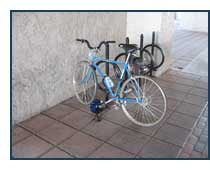 heeled my bike to the middle island of the transit center and hastily locked it to a free-standing bicycle rack. I made it on board the train with seconds to spare.
heeled my bike to the middle island of the transit center and hastily locked it to a free-standing bicycle rack. I made it on board the train with seconds to spare.
Now I’m sitting on the upper level of the Rail Runner, Train #500 to Santa Fe, departing the downtown Albuquerque Station at 6:20 a.m. This is the first weekend of operation for the brand new commuter train and the first time ever that a train has travelled from The Duke City to the City Different by climbing La Bajada Hill, a treacherous bluff that divides Georgia O’Keefe Country from the Southlands. The date is Saturday, Dec. 20, 2008 and the public gets to ride the train for free for the next three weekends.
The Rail Runner smells of Pine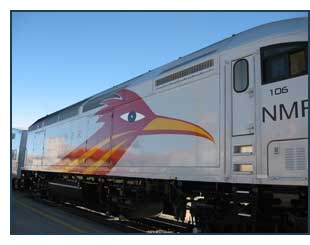 Sol and everything is spotless. The bright red upholstery, with its playful representation of the Rail Runner is spectacular: Not only does this colorful logo “brand” the locomotive with a cartoon image of a New Mexican roadrunner but its tail grows longer as additional cars are added to the train set. The closing of the doors are accompanied by Roadrunner’s famous call, “Meep-Meep! Meep-Meep!”
Sol and everything is spotless. The bright red upholstery, with its playful representation of the Rail Runner is spectacular: Not only does this colorful logo “brand” the locomotive with a cartoon image of a New Mexican roadrunner but its tail grows longer as additional cars are added to the train set. The closing of the doors are accompanied by Roadrunner’s famous call, “Meep-Meep! Meep-Meep!”
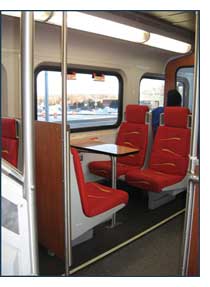 The carpet is clean and its enormous glass windows are crystal clear. I am seated on a cloth covered seat which does not recline, facing the direction of travel. The seats have about as much room as those found on an airplane and tables were interspersed between some of them. Above my head is a metal rack, perfect for personal belongings.
The carpet is clean and its enormous glass windows are crystal clear. I am seated on a cloth covered seat which does not recline, facing the direction of travel. The seats have about as much room as those found on an airplane and tables were interspersed between some of them. Above my head is a metal rack, perfect for personal belongings.
The conductor’s name is Ernie and he has welcomed us on board and reminds us that we are not in New York City and to keep our feet off the furniture. The train pulls out of Albuquerque station exactly on schedule, its horn a’blazing. It accelerates and we are buffeted from side to side on fifty-year-old tracks worn down by generations of long-haul passenger and freight trains. I am wearing my Cumbres Toltec Antique Railroad engineer’s hat.
It’s dark outside but I can see the lights of the city pass by.

The Rail Runner has just left the Los Ranchos/Journal Center Station and has picked up speed on its way to downtown Bernalillo. Meanwhile, I’m beginning to feel the lack of 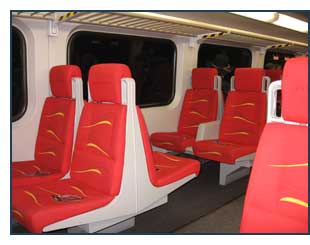 ergonomics in these seats. They are upholstered with fabric and cushioned with foam, shaped around a seat that is positioned way too vertically for my tastes. If the intent of the person who designed these seats was too keep anybody from feeling too comfortable, they certainly succeeded. The seats do not recline but I have found that a small cushion, placed under my thighs, near my knees, works wonders.
ergonomics in these seats. They are upholstered with fabric and cushioned with foam, shaped around a seat that is positioned way too vertically for my tastes. If the intent of the person who designed these seats was too keep anybody from feeling too comfortable, they certainly succeeded. The seats do not recline but I have found that a small cushion, placed under my thighs, near my knees, works wonders.
These seats don’t come close in comfort to the simple, bench-type accomodations one typically sees in a “heavy rail” commuter train like the Chicago Metra or the Long Island Railroad. But they are definitely a step up from what you would find on Los Angeles’ billion dollar, 14-mile-long Gold Line “light rail” train.
But I really shouldn’t be so critical: It’s a miracle the Rail Runner even exists. This is a crowning achievement of Governor Bill Richardson’s administration. The Rail Runner is a safe and dependable 97-mile rail system that can make all us New Mexicans proud and we got it for a bargain. Los Angeles’ 14-mile Gold Line, running between Union Station and Pasadena, cost twice as much money to build and covers only a fraction of the distance that our train covers.
Having overcome my initial shyness with the Rail Runner, I felt comfortable with walking through its cars. The seasoned Amtrak traveler will notice that the doors in the vestibules do not have a “power assist.” You have to really muscle them open if you want to move from car to car.
I have used the Rail Runner’s bathroom and give  it high marks. Only Amtrak’s Acella train on the Northeast Corridor ranks higher. There is plenty of room to move around its bathroom and everything is orderly, spotless and sensibly laid out. Not every car on the Rail Runner has a bathroom, so finding one may take some detective work.
it high marks. Only Amtrak’s Acella train on the Northeast Corridor ranks higher. There is plenty of room to move around its bathroom and everything is orderly, spotless and sensibly laid out. Not every car on the Rail Runner has a bathroom, so finding one may take some detective work.
Every seat in my railroad car is now occupied and the air is full of excitement and anticipation. I am resisting the temptation to get up and walk around because I may very well lose my seat. One ought never to underestimate a window seat that faces the direction of travel!
Every seat has a head rest and, on this third level, the seats are organized in groups of four, fa cing each other. This is a layout similar to that found in the Amtrak dining car. Such an arrangement encourages sociability, like it or not.
cing each other. This is a layout similar to that found in the Amtrak dining car. Such an arrangement encourages sociability, like it or not.
Facing seats tempt the uncouth to place their feet on the empty seat in front of them which is why the conductor told us to “keep your feet off the furniture.”
Another unintended consequence of having passengers face each other is that small children will have the uncontrollable desire to play “footsie” with you. I’ve had this going on for half the trip. The little girl across from me, with her curly brown hair, freckled face and upturned nose just has to keep her stocking feet extended all the way in front of her, pressing those precious feet directly on my knees. Her father is constantly pushing her feet aside but I just smile. I mean, what am I supposed to do? It’s not like she’s sticking a penknife into my leg.

Now we are passing through several Indian Reservations. The conductor has told us to respect the privacy of the Indian communities by not taking photographs.
The train parallels old Highway 66, giving passengers a view you could never see from a car cruising down Interstate 25. We pass by Santa Ana Pueblo, then comes San Felipe Pueblo, and then I see the mother of all irrigation ditches, the acequia madre. We’re following the same Northern route as Amtrak’s Southwest Chief!
The ride is jumpy because the track is made the old fashioned way, bolted together, instead of in one continuous ribbon. Every bump speaks of the meeting between metal wheel and track-rail junction. The ties are wooden, not concrete and the road bed is old.
The track and roadbed from here to Bernalillo is probably as old, if not older than I am. But as we pick up speed, we fly across the track so quickly that I can barely notice the 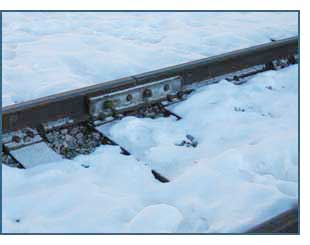 bumps: similar to the way you can fly over a washboard road in a car at just the right speed and not even feel a thing.
bumps: similar to the way you can fly over a washboard road in a car at just the right speed and not even feel a thing.
The conductor told me that the Rail Runner can reach speeds up to 79 mph. He said that the smooth track, with its concrete ties and continuous ribbon of rail, begins 25 minutes into the ride, when the train veers off along Interstate 25.
Although this is technically a commuter train, a tourist could delight in this ride because, once it leaves Bernalillo, it doesn’t follow roads. The Rail Runner cuts through arroyos, ranch land, and red rock country studded with pinon trees. As we travel north, I can see the mountains of Cerrillos approach, mountains once 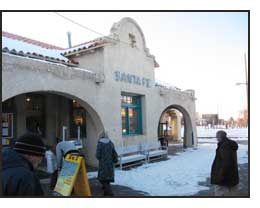 plundered by The Tiffany Company for turquoise during the late 1800’s, when an ounce of turquoise sold for more than an ounce of gold.
plundered by The Tiffany Company for turquoise during the late 1800’s, when an ounce of turquoise sold for more than an ounce of gold.
We divert from the Amtrak route and make our way up the 1,000 foot La Bajada Hill to Santa Fe and I can feel my ears pop. The train surmounts the mountain by making gradual turns, passing though brand new tunnels whose façade of molded concrete looks like massive hand-carved stone blocks.
The train begins to climb La Bajada Hill. It rides over brand new concrete ties and rail, over new bridges and tunnels and eventually settles between the two opposing lanes of I-25. We are on the homestretch now, approaching Santa Fe and the landscape is covered 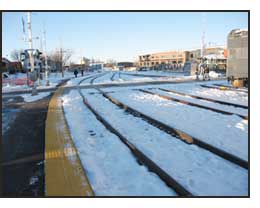 with freshly fallen snow. Neighboring cars try to keep up with the train and pass it.
with freshly fallen snow. Neighboring cars try to keep up with the train and pass it.
We enter Santa Fe.
So much has changed. There are fancy bars and restaurants within only a couple hundred feet of the station. There is even a warehouse that has been turned over to the restless teenagers, for their art and theater projects.

As I finish writing the above paragraph I look up from my keyboard, hoping to meet the eyes of Mr. Birdseye and win his approval. Instead I see nobody. I look around the lobby, hoping to see that lady with the blue jean cutoffs and tank top, or maybe a Harvey Girl, but all I see is a gaunt Georgia O’Keefe look-alike, wearing a full-length down jacket.
I shut down my computer and head out of La Fonda Hotel.

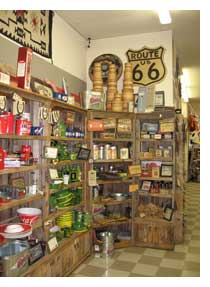 My first stop is at the Five and Dime for a Frito Pie. This slice of the old Woolworth’s survives under new management. It is one of the few places within walking distance that local residents can still stock up on necessities. It is also full of curiosities that would satisfy the most eccentric bargain hunter.
My first stop is at the Five and Dime for a Frito Pie. This slice of the old Woolworth’s survives under new management. It is one of the few places within walking distance that local residents can still stock up on necessities. It is also full of curiosities that would satisfy the most eccentric bargain hunter.
It is now past ten a.m. and I visit the The Palace of Governors and am pleased to see that the Palace Print Shop is under renovation and may soo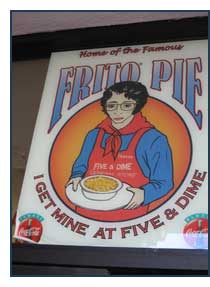 n open. I used to spend many a happy hour here chatting with Pam Smith, the curator, while she labored over her antique presses or made exquisite marbled paper. I visit the New Mexico Museum of Modern Art and am frustrated to see a Georgia O’Keefe’s paintings displayed under glass. I understand the gesture (there’s crazy people out there), but such protective measures take away from the painting’s impact.
n open. I used to spend many a happy hour here chatting with Pam Smith, the curator, while she labored over her antique presses or made exquisite marbled paper. I visit the New Mexico Museum of Modern Art and am frustrated to see a Georgia O’Keefe’s paintings displayed under glass. I understand the gesture (there’s crazy people out there), but such protective measures take away from the painting’s impact.
I walk The Cathedral Basilica of St. Francis of Assisi and see that it is under renovation. Its entire 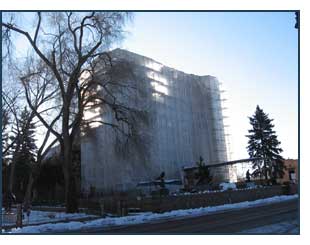 stone façade is covered in clear plastic, making it look very much like an environmental sculpture by Christo.
stone façade is covered in clear plastic, making it look very much like an environmental sculpture by Christo.
As I am strolling down East San Francisco Street, I pass by the Charles Azbell Gallery and am mesmerized by the alabaster sculptures of Navajo artist Haskey-Teh-Des-Wod. The 32-year-old artist 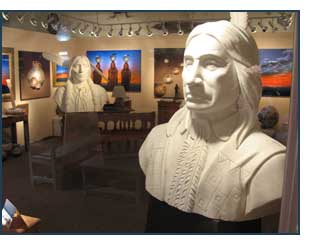 has, according to a hand-written card in the window, been exhibiting his pieces with the gallery since he was only 14 years old!
has, according to a hand-written card in the window, been exhibiting his pieces with the gallery since he was only 14 years old!
I visit the St. Francis auditorium and gaze at its magnificent, polished flagstone floor. Such craftsmanship is almost unheard of these days.
On the way back to the train station, I stop by the old Victorian mansion on Montezuma Street that used to be the headquarters of The Santa Fe Reporter. It is now a store of Tibetan and Far East artifacts and I asked the proprietor for a tour. Th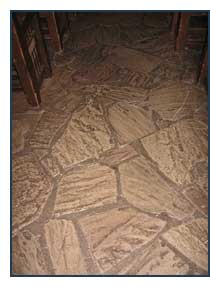 e publisher, Dick McCord, used to keep us typesetters and paste-up people in the basement. The reporters and editors occupied the third floor while the circulation department, accountant, ad reps and receptionist occupied the ground floor.
e publisher, Dick McCord, used to keep us typesetters and paste-up people in the basement. The reporters and editors occupied the third floor while the circulation department, accountant, ad reps and receptionist occupied the ground floor.
“I remember many a drunk writer falling down those steps,” I said to the proprietor as I worked my way up to the third floor, where Dick used to crack the whip and get his writers to churn out Pulitzer prize winning news stories.
What ever happened to Arts Editor Anna Dooling? She let me write some feature articles for the paper and tried so very hard to 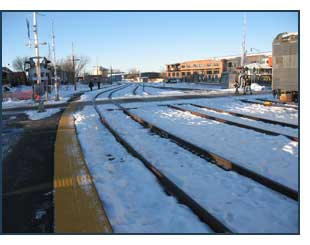 make me understand the importance of the “lede” in a story. And, for that matter, what happened to Bob Graybill, Stephen Terrell, John Robertson, Hope Aldrich and Roger Morris? We were like a big family. It was definitely a golden age, even if we didn’t make a lot of money. I mean, where else would they stock the refrigerator with beer or let you bring your dog to work?
make me understand the importance of the “lede” in a story. And, for that matter, what happened to Bob Graybill, Stephen Terrell, John Robertson, Hope Aldrich and Roger Morris? We were like a big family. It was definitely a golden age, even if we didn’t make a lot of money. I mean, where else would they stock the refrigerator with beer or let you bring your dog to work?
“This place has been through many re-incarnations,” my host said. How appropriate then, that it should be now dealing in Eastern matters.

It’s standing room only on the #505 departing Santa Fe Station at 11:30 a.m. A horde of people climb on the train and try to find a seat. It would appear that the good people of Santa Fe are more curious to check out the Rail Runner then Albuquerqueans are curious to check out the Santa Feans. Comfortably 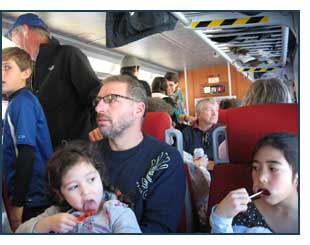 settled in by my pristine window, facing the direction of travel, I don’t envy those passengers who must endure the next 50 minutes standing up, because there’s nothing to hold on to.
settled in by my pristine window, facing the direction of travel, I don’t envy those passengers who must endure the next 50 minutes standing up, because there’s nothing to hold on to.
(One thing I notice: the train rings its bell when it goes through gentrified Santa Fe, but it blows its horn loudly when it runs through the gritty parts of Albuquerque.)
The Rail Runner creeps though Santa Fe and right through the middle of the intersection of St. Francis and Cerrillos Rd., past the NM School of the Deaf, running backwards through neighborhoods I didn’t even know existed.
Industry makes way for flat-roofed adobe residences and then comes miles and miles of brand new, freshly-graded, track. We begin riding between the two freeways and are passing the Santa Fe Downs, which has been closed for the last 13 years. I attended two Grateful Dead performances there in the 1980’s.
I am seated in a little cove that is located in the middle level of this train. There are curious nooks and crannies all over the train, and the one I have found, although it does not have a table, does have an armrest, and one should never underestimate the value of an armrest.
It’s pretty remarkable the way the engineers have constructed this route. Anybody who has travelled between Albuquerque and Santa Fe knows what an effort it is to surmount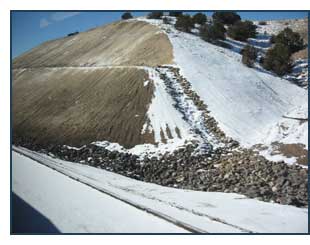 La Bajada Hill in a car. And although I can feel the altitude change in my ears, the grade that we are descending isn’t very noticeable. One would be hard pressed to find a smoother ride anywhere. As we make our way back to Albuquerque we are picking up speed, lots of speed, because we are heading downhill.
La Bajada Hill in a car. And although I can feel the altitude change in my ears, the grade that we are descending isn’t very noticeable. One would be hard pressed to find a smoother ride anywhere. As we make our way back to Albuquerque we are picking up speed, lots of speed, because we are heading downhill.
As we approach the bottom of La Bajada Hill I am pleasantly surprised to see Mr. Roger W. Birdseye waving at me beside the track, his arm draped around that beautiful woman I saw at La Fonda Hotel. This time she is wearing a cowboy hat, a western shirt and worn blue jeans, strategically ripped in suggestive places. Birdseye has a big smile on his face and he’s giving me the “thumbs up.”

“For the next 25 minutes we will be heading through Indian Country and we ask that you respect their privacy by not taking pictures,” we are reminded once again.
These Indian Pueblos are frozen in time and I am impressed by the lack of commercialism. I am told that they do have commerce, but it is kept very low key.
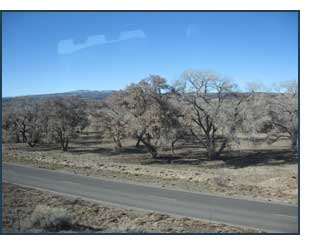 As I look out my very clean window, I see cottonwood trees lining the distant Rio Grande River. I see people by the roadside waving at us.
As I look out my very clean window, I see cottonwood trees lining the distant Rio Grande River. I see people by the roadside waving at us.
In the backyards of some Indian homes I see the traditional horno, a small domed adobe oven used for making bread. And alongside the railroad tracks I see the acequia madre again. It’s dry, this time of year, but during the planting season the farmers irrigate their fields with its water.
I see barren cottonwood trees and dry acquias, waiting for the spring floods. The ice and the snow is gone but the wind blows fiercely.

We approach downtown Albuquerque and we pass a mountain of old, dead appliances. We arrive in Albuquerque and the people disgorge from the train and flood the transit center, Albuquerque’s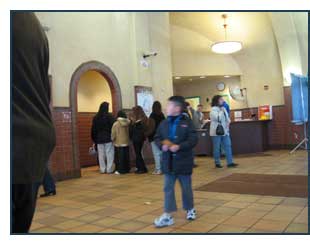 Grand Central Station. I try to imagine how our friends from Santa Fe must see us. The ATC is one of the first things that Rail Runners encounter and it’s no Chicago or Los Angeles Union Station: It is such an embarrassment.
Grand Central Station. I try to imagine how our friends from Santa Fe must see us. The ATC is one of the first things that Rail Runners encounter and it’s no Chicago or Los Angeles Union Station: It is such an embarrassment.
The ATC’s “Great Hall,” with its park benches, resembles a homeless shelter and doesn’t reflect Albuquerque’s rich railroading heritage: A small investment in rail-themed posters, or Alvarado memorabilia would brighten up this gloomy space.
I go to the bathroom to relieve myself and am 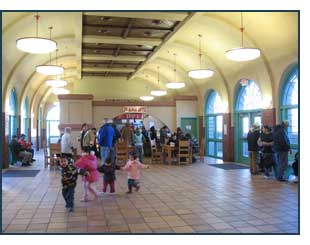 fortunate: I only have to wait a minute or two before I can use one of its three tired stalls. But I look over to a line, 15 deep, that has formed at the women’s bathroom and I think, “That’s not right.” The bathrooms on the train were palatial compared to those found at the ATC.
fortunate: I only have to wait a minute or two before I can use one of its three tired stalls. But I look over to a line, 15 deep, that has formed at the women’s bathroom and I think, “That’s not right.” The bathrooms on the train were palatial compared to those found at the ATC.
I walk outside, unlock my trusty ten-speed and ride back to my humble adobe house in Old Town, fighting the cold and penetrating wind but very glad to be home again.
Thank you for visiting chucksville.
|
|


